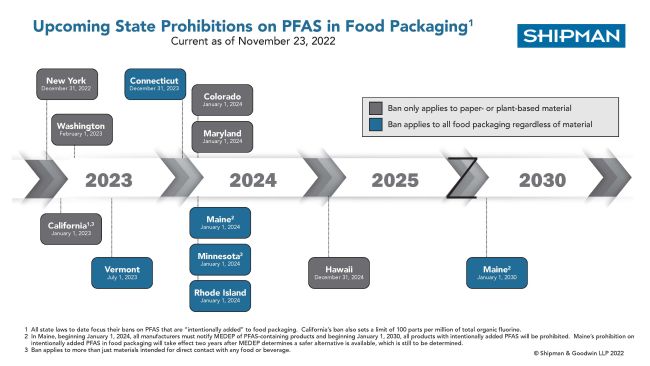New York and California are kicking off the new year by banning intentionally added per- and poly-fluoroalkyl (PFAS) in food packaging, effective 12/31/22 and 1/1/23, respectively. At least nine other states will follow with bans going into effect during 2023 and 2024 (see timeline below or download here). If you manufacture, sell or distribute food, beverages or product packaging, here is what you need to know.

Background
PFAS refers to a family of substances also known as "forever chemicals" because they are persistent and do not readily breakdown in the environment. PFAS are ubiquitous and bioaccumulate in animals and humans. They are found in many commonly encountered products, including non-stick cookware, waterproof/resistant materials, cosmetics as well as food and water sources. PFAS has been linked to a range of health concerns, including low infant birth weight, immune system impacts, elevated cholesterol, cancer and thyroid hormone disruption.
In recent years, the use of PFAS in food packaging has come under increased scrutiny. For example, a recent Consumer Reports study indicated PFAS is often found in plant or paper-based food packaging to make the packaging grease- and oil-resistant. The study also found that a number of fast food, "fast casual" and grocery chains had PFAS in their food packaging. Shortly after the report was released, separate class action lawsuits were filed against several identified companies (e.g., McDonalds, Burger King) for having PFAS in their food packaging.
Key Considerations of State Laws Banning PFAS in Food Packaging
As of December 2022, eleven states have enacted legislation banning PFAS in food packaging and five additional states are considering it. Generally, the state laws ban the selling, manufacturing or distributing food packaging with "intentionally added" PFAS and one state (CA) set a detection limit regardless of whether the substance is used intentionally. There are three key factors to consider in evaluating the extent of the bans:
- "Food packaging" is generally defined to include products used to contain, handle, transport, store, serve, protect and market food and beverage products (e.g., bags, containers, wrappers, tubes, cups) as well as the packaging components (e.g., blocking, seals, liners, inks, labels). In nine states, the food packaging is limited to material intended for direct contact with a food or beverage. The other two states (CA, MN) define food packaging more broadly.
- Six states are focused on food packaging made from paper, paperboard or materials derived from plant fibers. The remaining five states regulate food packaging regardless of its composition.
- All eleven states ban "intentionally added" PFAS, i.e., PFAS that are added to the food packaging to serve a specific function or provide a specific characteristic (e.g., non-stick). In addition, California's law also bans the presence of PFAS in a product or product component at or above 100 parts per million, as measured by total organic fluorine.
Federal Regulation Lags Behind States
Despite the increased state regulatory activity regarding PFAS in food packaging, as of December 2022, there is currently no federal law explicitly banning PFAS in food packaging intended for consumer use — although there is a narrow federal law banning PFAS in certain food packaging provided to the military. However, the U.S. Food and Drug Administration, responsible for regulating chemicals in food packaging and food handling products, is discouraging the use of PFAS in food packaging through a voluntary phase-out program that commenced in 2021. The lack of federal action has led a number of states to enact individual PFAS bans on food packaging, resulting in a patchwork of regulation and increased compliance costs for retailers, manufacturers and distributors.
Next Steps
Food and beverage manufacturers, including companies in the emerging cannabis space producing certain "edible" goods, should assess their food packaging supply chains and gather more information on what PFAS may be present, and to what degree, by reviewing applicable supplier Safety Data Sheets and requesting formal assurance in the form of "confidence letters" or "certificates of compliance" from suppliers. Notably, some states, like New York, provide a safe harbor for a food and beverage manufacturer or retailer if it has received written compliance assurances from its food packaging suppliers. Food and beverage manufacturers should expect to be asked for corollary compliance assurances from their downstream customers, vendors and retailers.
Food packaging is just one of many facets of the ever-increasing regulatory burden around PFAS. Thus, we recommend a proactive and coordinated legal and technical approach to developing an appropriate risk management plan to identify, mitigate and manage PFAS risks associated with past, present and future business operations. Our environmental team is prepared to discuss the potential implications of, and solutions for, the rapidly evolving PFAS landscape.
The content of this article is intended to provide a general guide to the subject matter. Specialist advice should be sought about your specific circumstances.





